Animal Farm
George Orwell's dystopian classic, with a ten-year-old. Terrible idea, or great idea?
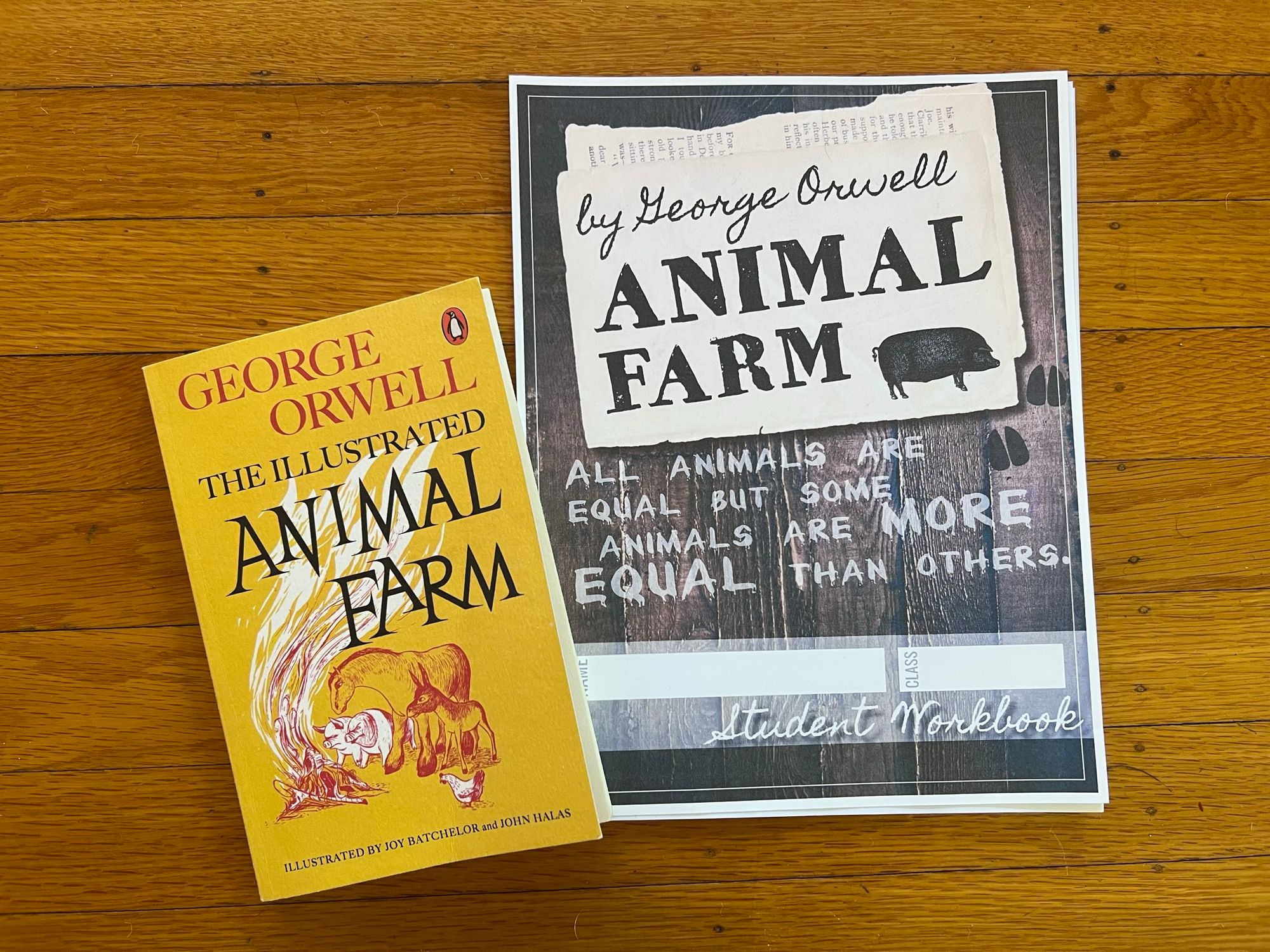
We just finished an in-depth study of George Orwell's short novel, Animal Farm. For those unfamiliar, or whose memory has become fuzzy since reading it in school, it is about a group of farm animals who revolt, oust the human farmer, and take over the farm for themselves. Orwell wrote the story in 1944 as a satirical commentary on the Russian Revolution, and in particular on how far Stalin had strayed from the ideals of Karl Marx's Communism.
It's a peculiar choice for a fourth grader, I'll grant you. Animal Farm is more commonly taught in high school or middle school. I wanted to test the waters of more complex reading with Wanda, and this felt like a great place to start. It has several things Wanda enjoys: animals, satire, complex social interactions, and humor. She also had some familiarity with the Russian Revolution, which helped.
As luck would have it, a homeschooling friend of mine happened to be considering Animal Farm for her own kid, and pointed me to an Animal Farm teaching resource by Stacey Lloyd on Teachers Pay Teachers. That resource turned out to be a huge help, and formed the backbone of our learning. There are two main pieces to her Animal Farm bundle: a 75-page teaching guide, with 17 detailed, nearly-scripted classroom lessons, and a 40-page student workbook, ideal for more independent learners to fill in on their own. There's a fair amount of overlap between the two, but enough differences that we used both. The lessons and workbook are intended for a high school classroom, and I'll detail later in this post how I adapted it for use by a much younger kid in a homeschool setting.
Animal Farm is a short book—just ten chapters, 115 pages—but we took our time with it, reading about two chapters a week, and doing quite a bit of foundational work before we even cracked the spine of the book. It took us about two months (with a vacation week in there), and was done in place of our normal language arts learning. (We had just finished Michael Clay Thompson's Town level, and this was done before starting the next MCT level, Voyage.)
Laying the Foundation
Before we started reading, I wanted to ensure Wanda had enough understanding to fully appreciate what Orwell was doing with his book. This meant spending some time on understanding political systems, the Russian Revolution, and also digging into the literary concepts of allegory and satire. Stacey Lloyd's resource was a great guide for this, and I added a few other resources, too.
Stacey Lloyd's Animal Farm guide starts gentle, with a few days spent exploring the concepts of allegory (via Aesop) and satire (via Shrek and political cartoons; Wanda greatly enjoyed this lesson!).
Next we learned about some political concepts and terminology, terms like capitalism, communism, socialism, dictatorship, bourgeoisie, proletariat, etc. Wanda and I had fantastic discussions here, and this was the first point in this project where I felt like maybe I was onto something with this crazy Animal Farm idea. We spent some time learning about Karl Marx, in particular seeking to understand the difference between "communism" as Marx described it, and "communism" as it took shape in countries such as Russia and China. We also learned a bit about the differences between Communism and Socialism, and the differences between Communism and Capitalism. Here are some YouTube videos we found helpful:
As luck would have it, we happened to watch two relevant videos during other, unrelated lessons at this same time. The universe smiled on us, the timing could not have been more perfect! In our geography learning, we watched this video from the Crash Course Geography series (which is excellent) about Communism and Capitalism.
And in our history learning, we watched an episode about Capitalism in Hulu's 1619 Project documentary series. The history of human enslavement in the United States comes up a lot in our learning because the unhealed scars run deep and continue to shape our world, and we have to do our part to put things right. The Capitalism episode looks at the role our economic system plays in perpetuating the inequities in our society, as it follows the efforts by workers at two different Amazon warehouse locations to unionize.
Being able to discuss the same thread across subjects deepens the learning. I love it when that happens.
To wrap up our learning of the terminology, I put some of the terms up on our whiteboard with the intention of doing a quick verbal review of what each one means. Wanda grabbed a blue marker to create these little graphic icons for each of the political terms, and I thought they were really cool.
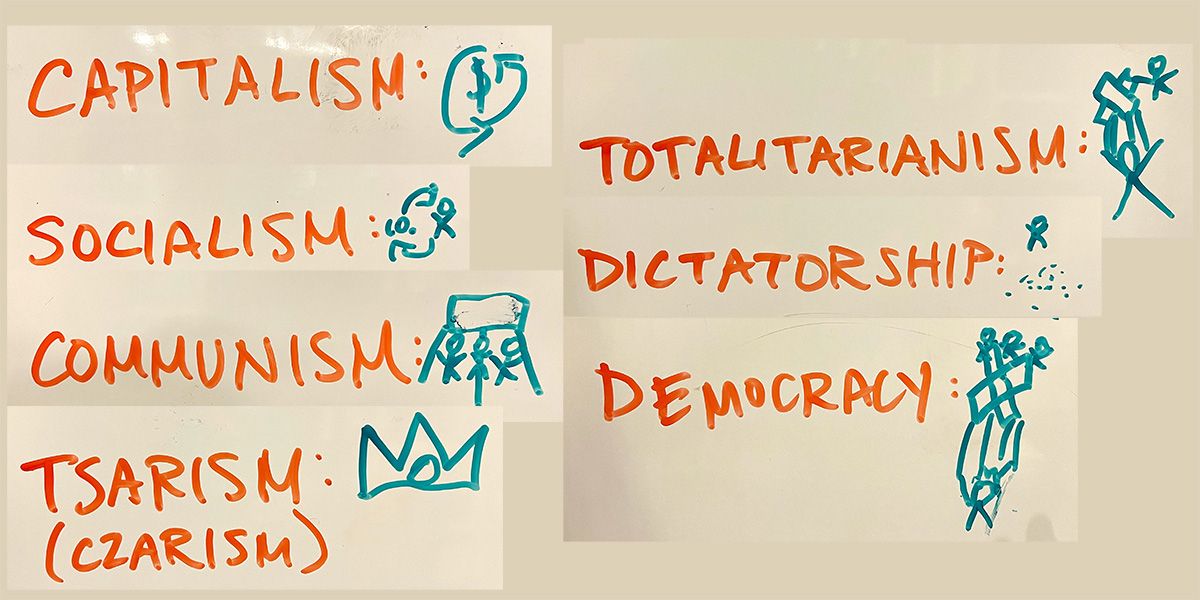
Now it was time to take those political terms and ideas, and bring them into a dive on the Russian Revolution. For this, we had a big assist from OverSimplified's two YouTube videos about the Russian Revolution. Wanda had already seen them and loved them, and was happy to watch them again. Together they're about one hour.
Of course, the real reason we want to do this kind of in-depth learning is so we can get all the jokes. For dessert, we enjoyed a couple of old Monty Python clips:

Reading the Book
By this point, Wanda was starting to get very itchy to read the danged book already!
You can get a feel for what we covered alongside our book reading by looking at the description of Stacey Lloyd's lesson plan. Some of the literary topics we covered included persuasive speech, characterisation, symbolism, narrative perspective, and identifying themes.
Chapter by chapter, I read the book out loud, pausing frequently for discussion. We talked about what was happening with the characters in the novel. We discussed how it connected to the events of the Russian Revolution, and where we see echoes of these same power struggles in today's world.
As much as possible, I left room for Wanda to figure out the way Animal Farm mapped onto the Russian Revolution on her own. Rather than come right out and say "Napoleon is Stalin," we had a big discussion together to identify who was who, where I tried to do only the bare minimum of prompting. This kind of learning—time-spaced from the initial learning, where she has to reach a bit in her memory to find the answer—cognitive research points to this being extremely effective for enhancing learning retention.
Some elements in the story were things that were unfamiliar to her—for instance, the secret police that are represented by the dogs, and the propaganda outlets represented by the pig Squealer—and in those cases we paused to learn a bit more about the history before moving on.
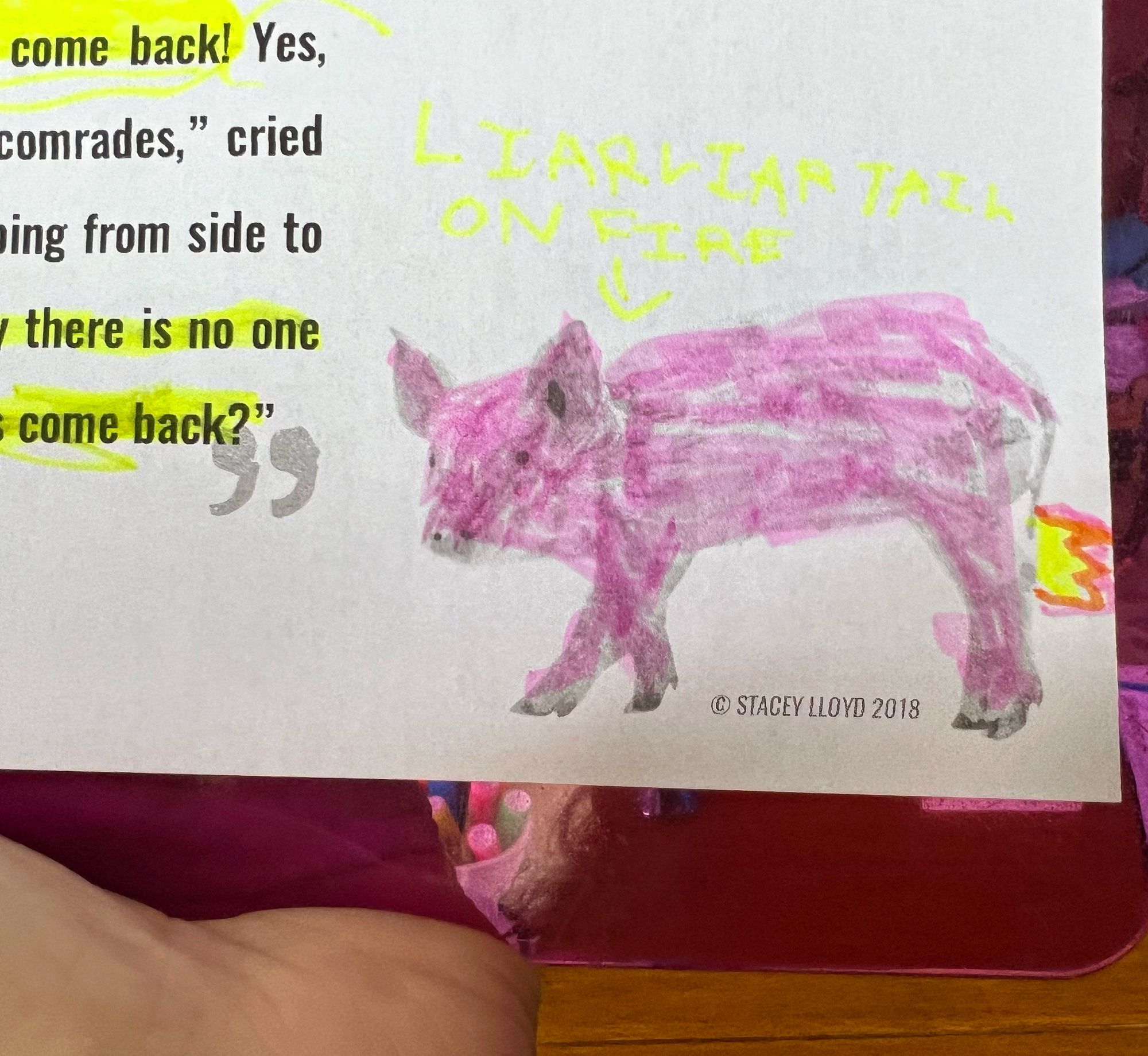
Squealer turned out to be one of Wanda's favorite characters. She delighted in yelling out, "LIAR, LIAR, TAIL ON FIRE!" whenever he was twisting the truth, which was a lot. Wanda loves being critical of media sources. She's the first to blurt out, "this is a commercial!" when a news item shows up that clearly was driven by some company's PR department. She sees right through your police-state robot dogs, Boston Dynamics. She does not think they're cute. Here's a video we watched as we learned more about propaganda:
Especially as we got closer to the end of the book, we talked about what Orwell may have been wanting to say, and how that shaped the choices he was making as a writer. We also did a lot of talking about the recurring themes around power, corruption, propaganda, education, and inequalities, how we see these same themes happening in our world, and how every generation needs to fight against these same tides to strive for true equality.
The story starts fairly hopeful, but turns dark. Wanda was prepared for this, as she remembered a reference to Animal Farm in her Michael Clay Thompson vocabulary book that painted a bleak picture. I wasn't completely sure how she would handle the harsher moments—there are some brutal murders in the book—but I needn't have worried. I think it helped that she understood this was tangling with some very real atrocities that are worth confronting, and it helped that the book is, after all, a fairy tale.
Wanda's favorite chapter—by far—was chapter 8. That's the chapter where the pigs discover a cache of whiskey, and get drunk. After we read chapter 8, she told me: "I know there will be more drunk pigs. He was making chapter 8 funny because chapter 7 was so dark, and I know the book is going to get darker before it ends, and he'll need drunk pigs to counteract that." She was right, of course, but I'm sure she'd tell you the book could have used even more of the drunk pigs.
Adapting the teaching resource for a 4th grader
As mentioned, Stacey Lloyd's Animal Farm bundle includes both classroom lessons and a student workbook. They have enough overlap that you really only need one or the other, but I used both. We typically started with the classroom lesson elements and then did the relevant student workbook pages together before moving on to the next lesson.
Lloyd says to expect the whole lesson to take about a month, and I think that's about right for a high school classroom. We took twice that long, and while I probably could have tightened some of it up and gone through it more quickly, I feel fine about the time we took. There were some vacation and other break days in there. We school year-round, so there's no rush.
Stacey Lloyd's plans call for a fair amount of written output, which is completely appropriate for high schoolers, but it was too much to expect of Wanda. I was more interested in stimulating deep thinking than getting writing practice. I've learned the hard way, over and over again, that combining too many nascent skills at once can make the learning go kerplooie. So we did most of the work verbally, or with me scribing, though Wanda did write some. (We continued to get daily writing practice in our other lessons, mostly Exploring the World through Story.) Lloyd provides complete answer keys for all of the lessons and the workbook, which were a big help for me in making sure we hit all the right beats in our discussions.
Over and over again, Lloyd's lessons expect the student to back up their assertions with quotes and evidence from the book. This was wonderful practice for Wanda, both for the practical act of tracking down a quote, and the general idea of making sure you can back up what you say to make a stronger argument.
One thing I really appreciated about the student workbook is that each chapter has lots of short activities in varying styles, with plenty of opportunities for creativity, including some drawing. It was also visually appealing, which helps Wanda a ton. That made it pretty easy adapt for use with a younger kid.
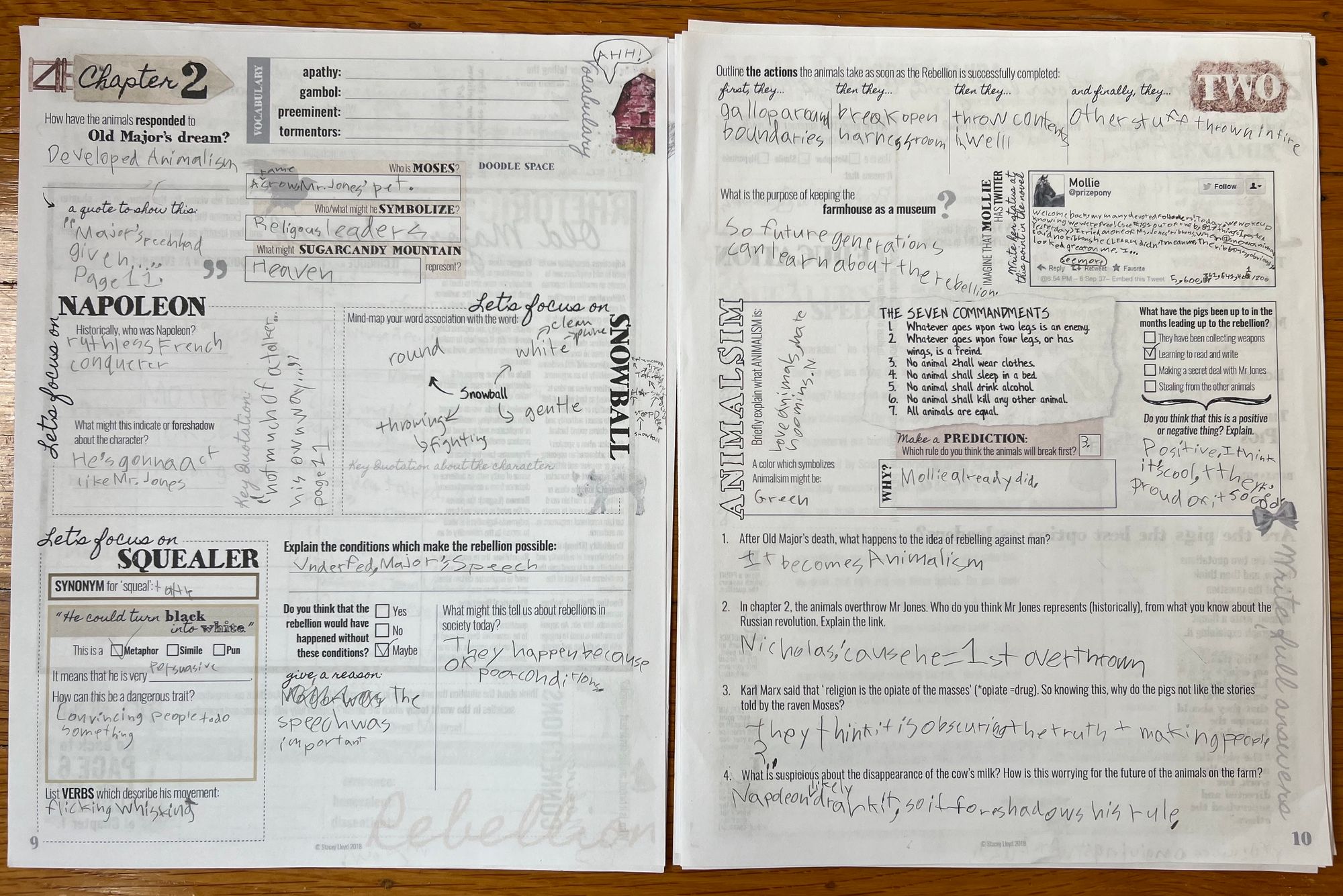
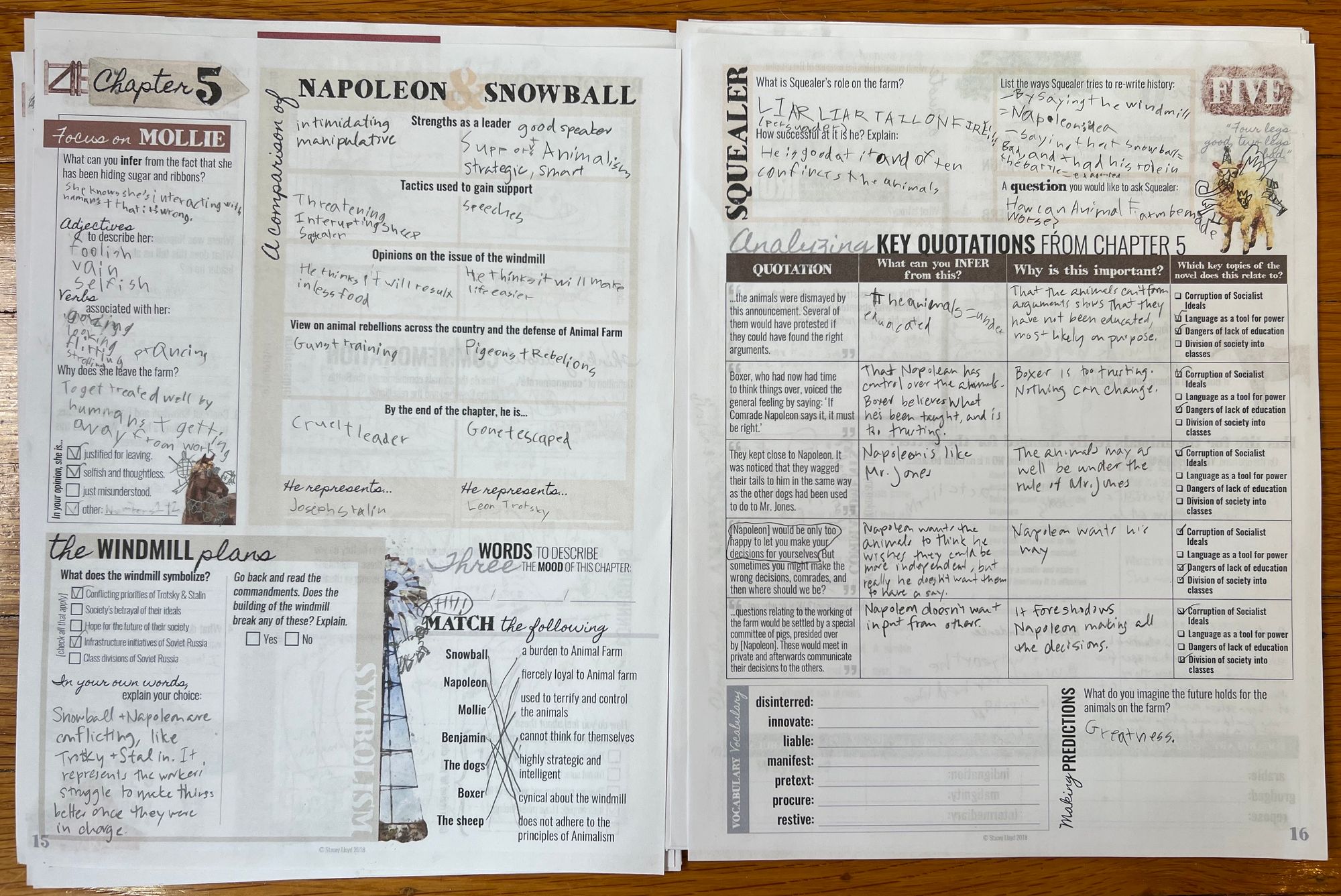
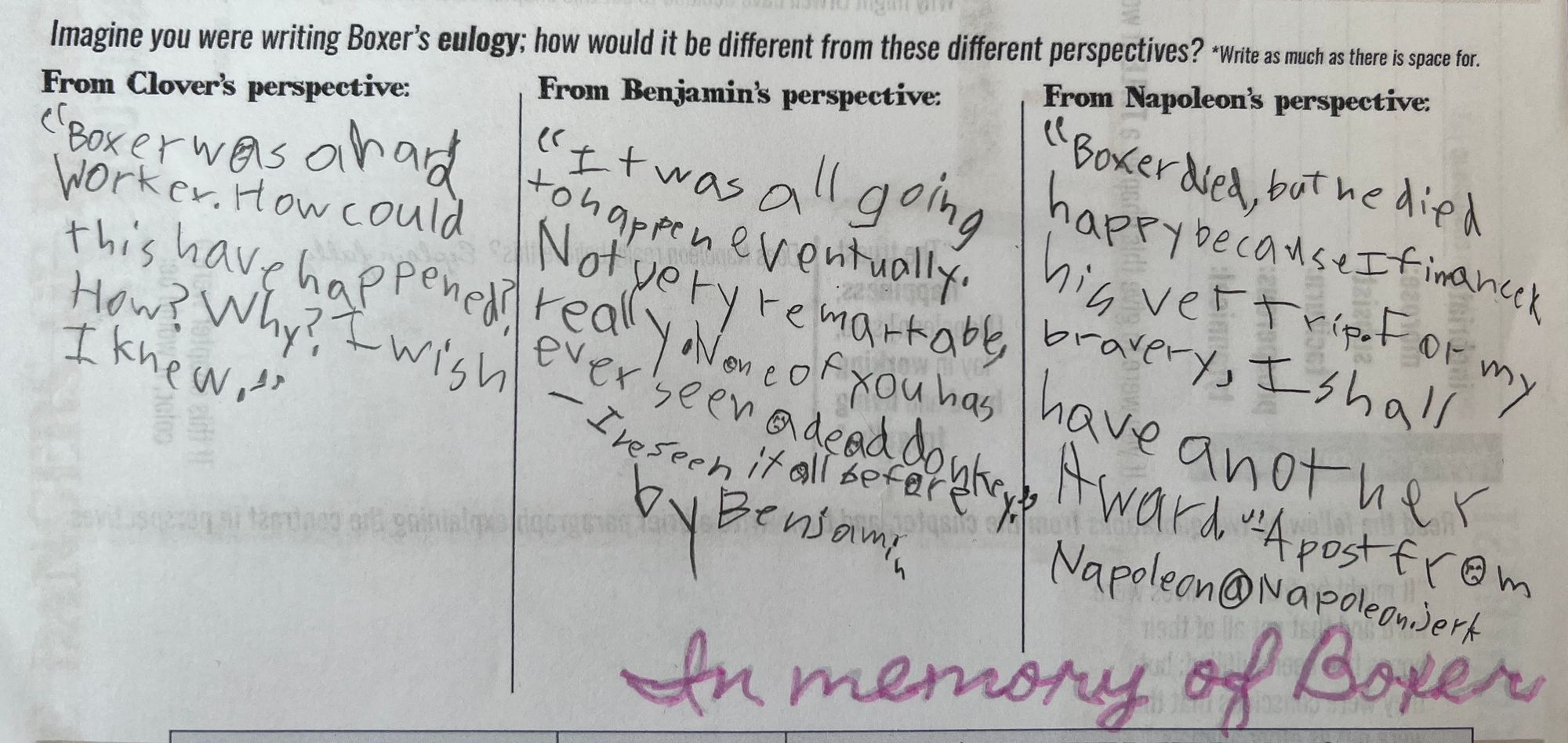
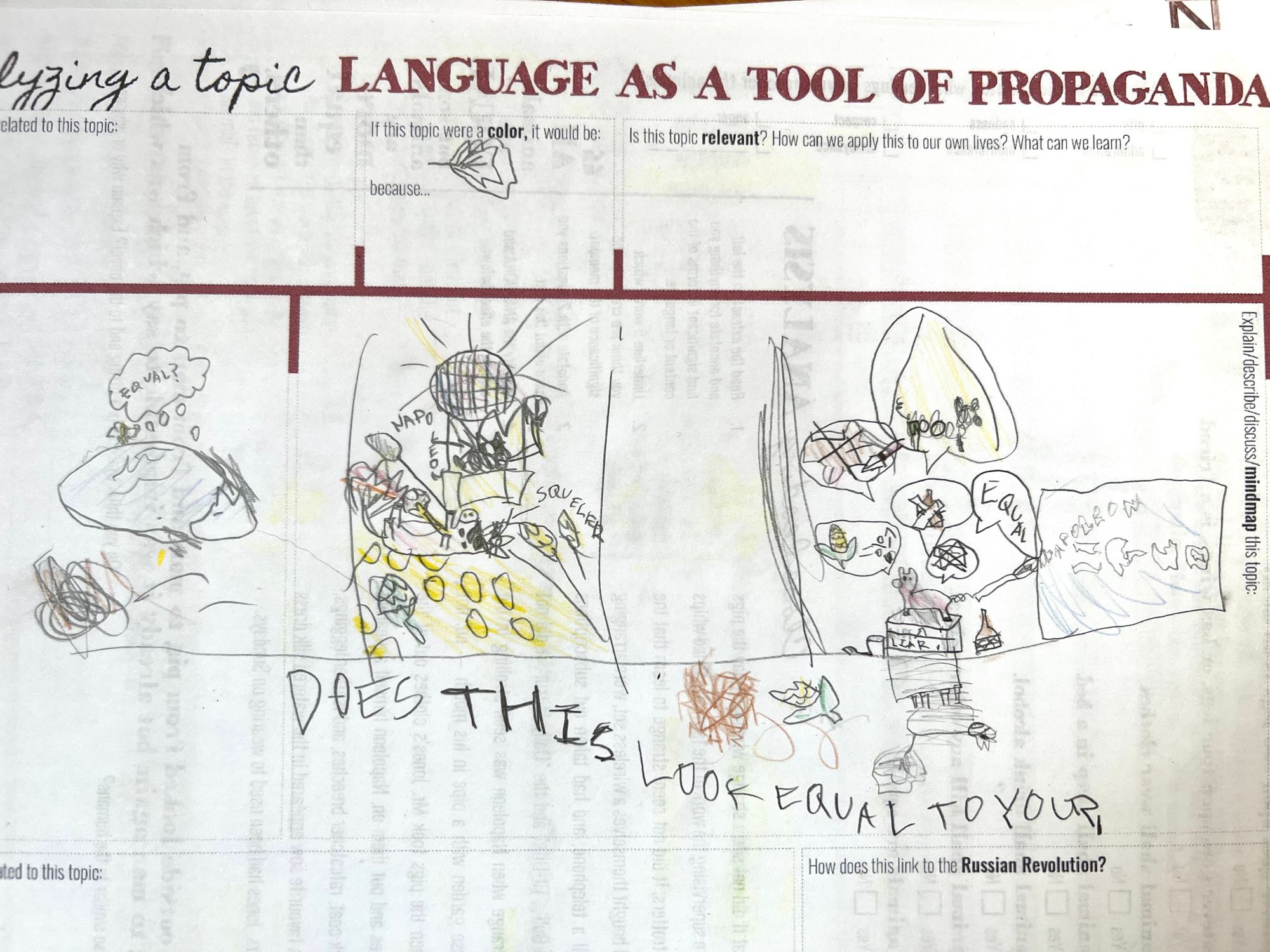
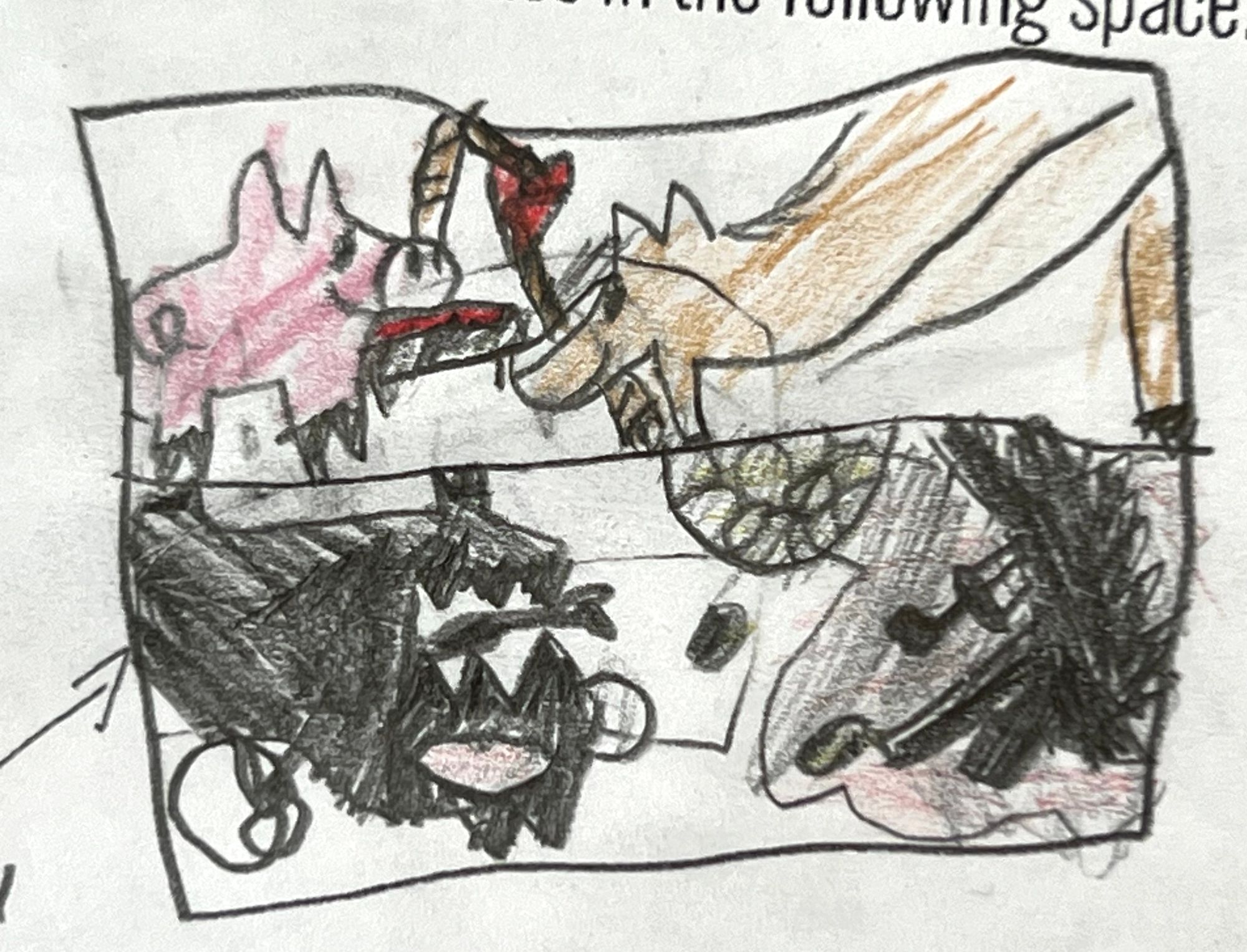
Wanda drew many little bits of art reflecting her thoughts on the book as we went. This drawing is pretty teeny in real life, it's not even two inches across, but I think it's just fantastic. The top half shows Napoleon and Boxer, as Boxer sees things. It's a cute, colorful scene, an idealized view of the world. Napoleon is being fed from a trough, provided to him and being lifted by Boxer's hard labor, which he does with love (symbolized by the heart on the rope). But if you look closely, that trough is filled with blood. Below is an upside-down shadow world reflection of the true nature of things: Napoleon is drawn in harsh, brutal lines, with jagged teeth. The trough is full of riches, from the labor stolen from the animals. And poor Boxer lies in a pool of his own blood, a sword through his heart, killed by Napoleon. This is from a mindmap activity after Boxer's betrayal in the book.
Wrapping it up
One of the final lessons in Lloyd's pack, after the book has been finished, is a fun final quiz day. I had to do a little conversion from a group classroom quiz into something that worked for just the two of us. It was a combination of quiz questions, both verbal and written, and some fun Pictionary-style drawing. Wanda loved it, and she did very well, getting almost every question correct!
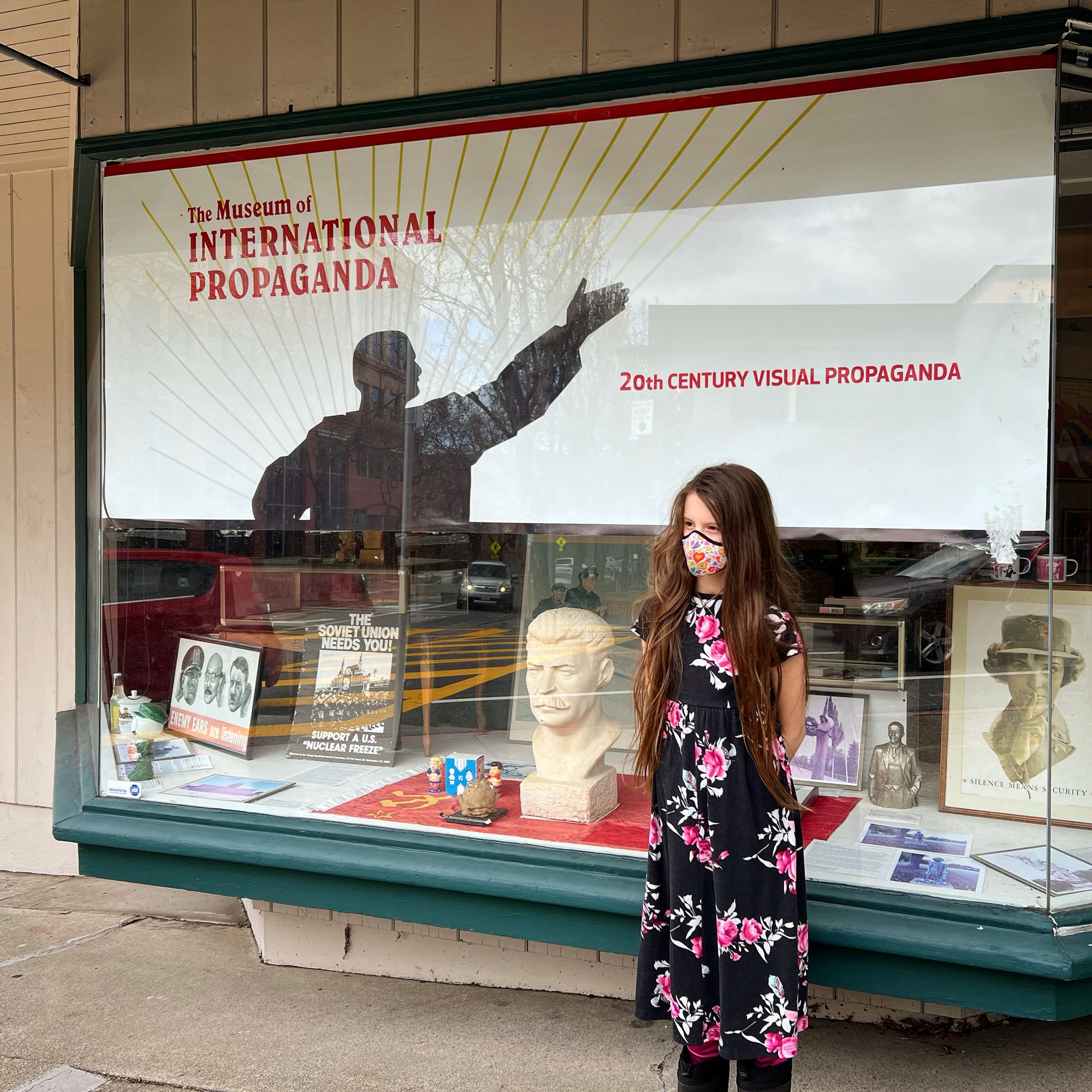
The next day, we did something very special, indeed: we took a field trip to the Museum of International Propaganda, just north of us in San Raphael! It's about a 50 minute drive from our home in San Francisco, and it was well worth the trip—I'm already hoping to visit again. It houses a huge collection of 20th century visual propaganda, from 25 different countries. The way the collection is presented is fantastic: it's grouped along seven themes, which mapped beautifully onto some of the same themes we saw over and over again in Animal Farm. We were able to draw a direct line from the story to actual propaganda in the real world, not just from Russia but from many other countries, including the United States. Each item in the collection is paired with a short write up, giving a translation of any text, and providing the context critical to understanding. The museum website has a few short videos with museum co-founder Tom Areton describing a few interesting pieces. Oh, it was wonderful. How lucky are we to have a resource like this in our backyard? Admission to the museum is free, but I happily gave a donation as thanks.
For our final lesson, we wrote an essay. Well, that was the plan: for us to write one together, because we haven't really started to learn yet about essays, but we will in this coming year with the Voyage level of Michael Clay Thompson. But Wanda wasn't having it. She insisted that she do it on her own, in her own way. So I did what I could to set some expectations: academic tone, at least three paragraphs, each one well-constructed, each paragraph about a distinct idea, all of the paragraphs making sense together. Then I took a deep breath and got out of her way.
This is what she wrote, shared with her permission. I did catch a spot where she missed a space between a word and a parenthesis, and I did insist we remove a bit about how the book would have been improved if it had some Homestar Runner characters in it, but other than that, this is all her:
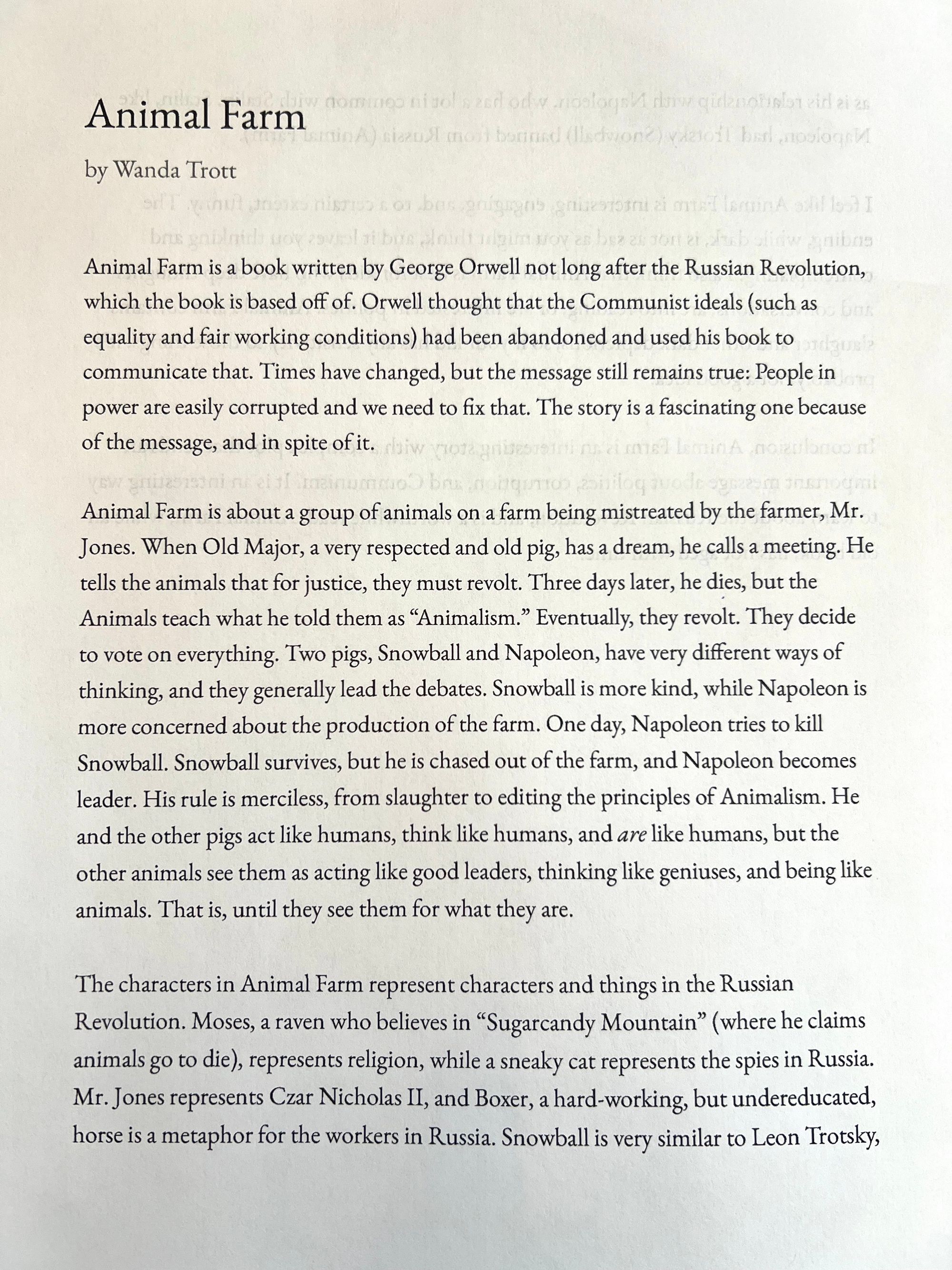
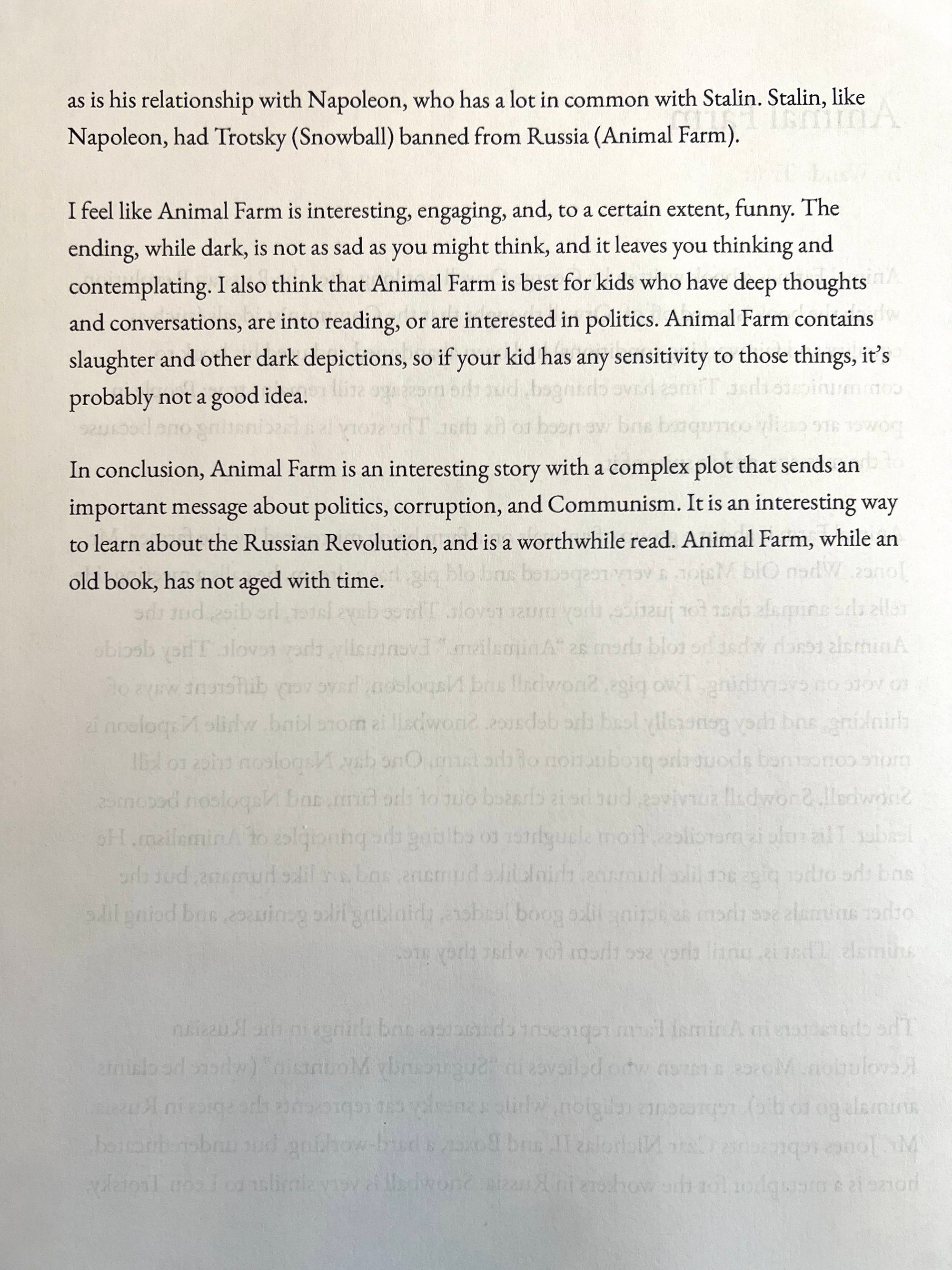
I am thrilled with this. OH HELLO THERE, SWEET SWEET VALIDATION! Studying Animal Farm with a 10-year-old wasn't an entirely terrible idea! Hooray!
We wrapped it all up by watching the 1954 British animated film version of Animal Farm. We discussed how it differed from the book—most notably in how it was crudely simplified, and missing a lot of the deeper meaning of the book. We were disappointed that the few female characters from the book were gone, that there was so little dialogue, that there was no rousing Beasts of England song, and Wanda in particular thought she was cheated, she should have seen some spectacularly drunk pigs, not just fleetingly tipsy ones! I saved the best bit of info for last once the film was done: that this film was itself a piece of anti-Communist propaganda, having secretly been produced by the CIA. Dun dun duuuuun!
I adored this time we spent with Animal Farm. It gave me the most tantalizing glimmer of what's to come in the next few years of learning with Wanda. I am so glad that I trusted my gut when it told me that Wanda was ready for some meatier material. And I'm grateful that she gave this a chance, too. We do need to shift back to our more standard language arts learning, at least for a while, but I'm already daydreaming about our next in-depth studies. (I have my eye on this Midsummer Night's Dream unit, and this collection of short story lessons.)

